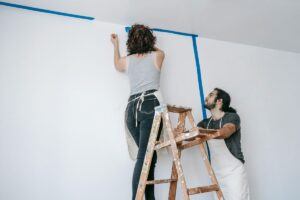A good friend of mine once found an old wooden door outside an abandoned housing and decided to turn it into a diy headboard.
I love to upcycle and make the most of what we already have so thought this was a great idea.
How to Create a DIY Headboard
The original door was an untreated oak door so let’s assume you’re starting from the same point.
1. Paint the Wood
You’ll need a least two coats of Sherwin Williams Reclining Green. You can use whichever color you want – my friend used the same color to match her bed quilt.
The paint my friend used was meant to give a semi-gloss finish, but it turned out pretty flat on the door. Keep in that in mind when you decide on your own color.
2. Glaze the Wood
When my friend started this part, she asked me to help out which I was super happy to do.
Because of where we live there aren’t that many glazing choices available at the paint store so my friend decided to go for Old Masters Gel Stain in Dark Walnut.
It did a great job but was a little thick, sticking to the wood more than other types of glaze might have done.
We had planned to try and a small test area on the wood and wipe off the excess with a damp cloth but, it was so thick it wasn’t coming off at all.
3. Aim for Consistent, Thin Layers
A change of plan was needed. Instead, we used dry brushes the glaze onto the door in small amounts. We would do small areas at a time, taking off any excess with a paper towel.
By doing this it looked like wasn’t anything on the door which meant we could apply a consistent, thin layer first before brush long stroke across the door.
It wasn’t perfect since some areas of the door look had darker patches – but that’s was fine since my friend was hoping to have a rustic feel to the finished door.
4. Use the Glaze to Give the Door Definition
My friend was aiming to have the panels to stand out from the rest of the door. To do this, she used a cotton wool bud to wipe the glaze along the edges of each panel.
By making the edges darker, meant the panels would be more defined. She also used a small brush and ran it along the raised edges of the panels – this also put more glaze on them giving better definition.
5. Blend the Glaze and Paint
Once the glaze had dried, my friend used a light grade sandpaper to gently blend the glaze and paint.
After the glaze had dried, it still wasn’t quite the look she wanted so she used the paint and with a dry brush, dabbed parts of the glaze to help with the blending.
6. Sandpaper and Final Layer
Once everything had dried, she gave the door was last sanding. Obviously, the paint should rub off onto the bed linen and pillows so my fiend finished the door with a couple of coats of semi-gloss polycryclic.
Once it was hung behind the bed, it look amazing! The Reclining Green paint color went really well with the bed comforter and the dark brown glaze matched the rest of the furniture in the room.
More Articles From Mama Say What?!
- How to Make Delicious and Healthy Turkey Meatballs
- A Quick and Easy Green Beans, Potato and Chicken Recipe
- The Best Would You Rather Questions to Liven Up the Festive Holidays
- How to Make Easy Chocolate Chip Zucchini Muffins
Featured Image Credit: Shutterstock
Tim Thomas is a renowned writer and entrepreneur specializing in finance, investing, and money matters. With his extensive knowledge and experience in the financial sector, Tim offers valuable insights into the world of personal finance, stock market trends, and investment strategies.





